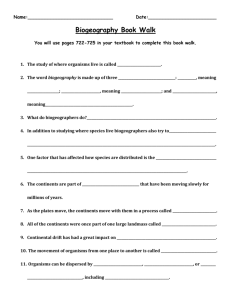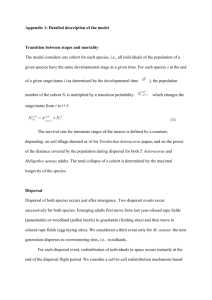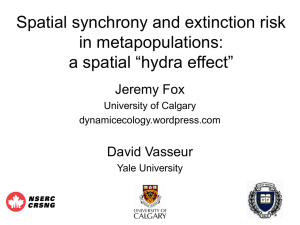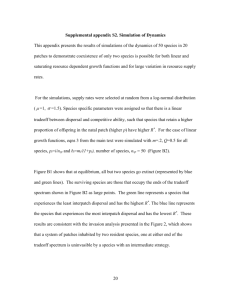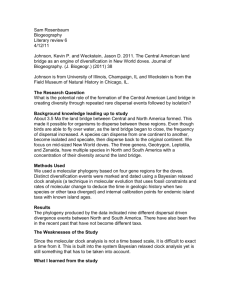ele12275-sup-0001-Appendix
advertisement
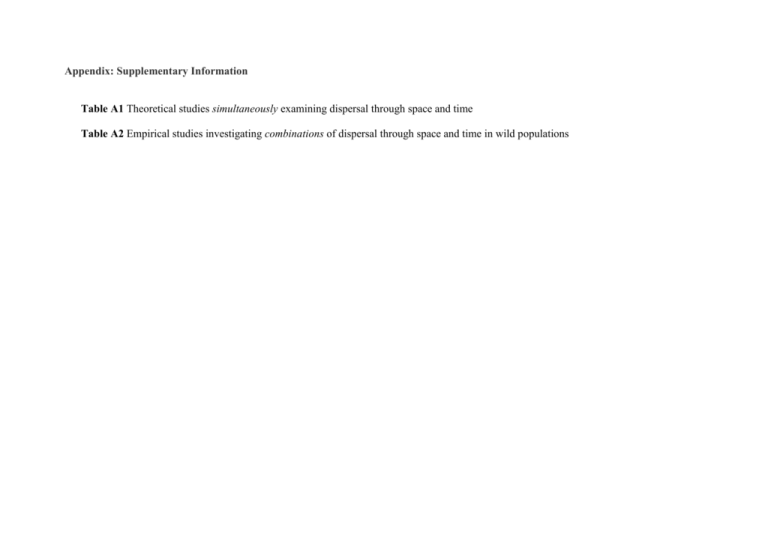
Appendix: Supplementary Information Table A1 Theoretical studies simultaneously examining dispersal through space and time Table A2 Empirical studies investigating combinations of dispersal through space and time in wild populations TABLE A1 Type of dispersal Authors Approach Type of regulation Temporal Den Boer (1968) Review / Idea Reddingt us & Den Boer (1970) Numerical simulations Southwo od (1977) Review / Idea Venable & Lawlor (1980) Bakshtan sky (1980) Analytical results Review / Idea Densitydependent / Densityindependent Densityindependent Spatial Covariat ion of dispersal strategie s Level of biological organizatio n Spatiotemporal correlation of the environmen t Conditi ondepende nt dispersa l Approach for studying consequen ces Metric of dispersal (Spatial/Tem poral) Stages of the dispersal process (Spatial/Tempo ral) Dormancy / Diapause / Age-structure Unspecifie d Individual, Population, and Species No Unspecified/ Unspecified Unspecified / Unspecified Age-structure Unspecifie d Population No Dispersal rate / Age structure variability Emigration / Emigration Dormancy Unspecifie d Individual No Dispersal distance / Dormancy duration Emigration / Emigration Dormancy Unspecifie d Individual (plants producing two morphs) Yes (predicta bility of germinat ion) Age-structure / reproductive strategy (iteroparity vs semelparity) Straying of adults outside of their natal river Negative Negative Species No germination fraction Dispersal rate / Dormancy rate Emigration / Emigration Straying rate / Age structure variability Unspecified / Unspecified Main results Spatial and temporal dispersal allow spreading of risk and contribute to population stability. Heterogeneity of the environment and within a population contribute to population stability. Organisms adopt strategies that vary in space and time to maximize reproductive success. Negative covariation between spatial and temporal dispersal strategies evolves in an unpredictable environment. The age complexity among salmonid fishes is a form of “protection in time” while spatial dispersal between populations is a Age-structure / reproductive strategy (iteroparity vs semelparity) Straying of adults outside of their natal river Negative Species Straying rate / Age structure variability, reproductive strategy Quinn (1984) Review / Idea Levin et al. (1984) Analytical results and numerical simulations / Population model without structure Densitydependent/F requencydependent Dormancy Unspecifie d Negative Individual No No Cohen & Levin (1987) Analytical results and numerical simulations / Population model without structure Densityindependent Dormancy Unspecifie d Negative Individual No No Evolutiona rily Stable Strategy Emigration / Emigration Dispersal rate / Dormancy rate Emigration / Emigration Dispersal rate / Dormancy rate Emigration / Emigration form of “protection in space” Temporal dispersal may be balanced by spatial dispersal within the Pacific salmonids Negative covariation between dormancy and spatial dispersal evolve because both are mechanisms for escaping environmental unpredictability. Both spatial and temporal dispersal are expected to increase if the variability of the environment increases. The covariation between spatial and temporal dispersal is also affected by temporal autocorrelation of environmental conditions. Negative covariation between spatial and temporal dispersal evolve in an unpredictable environment but the covariation is affected by costs Seger & Brockma nn (1987) Review / Idea Klinkha mer et al. (1987) Analytical results and numerical simulations Venable & Brown (1988) Numerical simulations Densitydependent / Densityindependent Densityindependent /Frequencyindependent Dormancy Dormancy Unspecifie d Unspecifie d Negative Negative Dispersal rate / Dormancy rate Emigration / Emigration Individual (one population with many patches) No No Dispersal rate / Germination rate Emigration / Emigration and Transfer Individual Yes (with /without temporal/sp atial correlation, respectively ) No Dispersal rate / Dormancy rate Emigration / Emigration and Transfer (via survival) of dispersal. Spatial and temporal dispersal can be interpreted as bet-hedging strategies and both can promote coexistence of species. Observed negative correlation between spatial dispersal and delayed germination in annuals plants, including from models with both densityindependent and the densitydependent regulation. Spatial and temporal dispersal allow an escape from sib-competition. Dormancy, dispersal, and seed size interact to reduce risk in temporally and spatially variable environments, and are partly substitutable. Increasing (positive) spatial autocorrelation of environmental conditions favors decreased spatial dispersal and increased dormancy. Philippi & Seger (1989) Review / Idea Cohen & Levin (1991) Analytical results Densityindependent Dormancy / Diapause Unspecifie d Dormancy Unspecifie d Negative Individual No No Dispersal rate / Dormancy rate Emigration / Emigration Yes (temporal autocorrelati on) No Dispersal rate / Dormancy rate Emigration / Emigration Increasing (positive) temporal autocorrelation favors decreased spatial dispersal and dormancy. Temporal and spatial dispersal are complementary and partially substitutable. Increasing number of patches within a meta-population favors spatial dispersal as a risk-spreading strategy while temporal dispersal and spatial dispersal both decrease with increasing (positive) temporal autocorrelation in the environment. Temporal dispersal reduces spatial dispersal at all levels of temporal autocorrelation in the environment. The effect of temporal dispersal is strongest when there is a negative temporal environmental correlation, is moderate at zero Wiener & Tuljapur kar (1994) Analytical results and numerical simulations / Matrix model with structure Eriksson (1996) Eriksson & Kiviniem i (1999) Dormancy / Age-structure Unspecifie d Negative Individual (one population with two subpopulations) Review / Idea Dormancy Unspecifie d Negative Species Review / Idea Dormancy Unspecifie d Densityindependent Yes No No No Long-term growth rate Dispersal rate / Dormancy rate Emigration / Emigration and Transfer (via costs of migration) Unspecified/ Unspecified Unspecified / Unspecified Dispersal distance / Unspecified Emigration / Unspecified correlation, and is weak when the environment is positively autocorrelated. Spatial dispersal is favored in variable environments, by negative spatial autocorrelation, and by a large population structure but the benefits are reduced when temporal dispersal also occurs. Temporal dispersal contributes to population buffering and increases the time to extinction even in declining populations. Proposed the concept of remnant populations (populations which disperse in space and time) as an alternative to metapopulation and source-sink approaches. Review of spatial and temporal dispersal strategies in plants that revealed the Eriksson (2000) Review / Idea McPeek & Kalisz (1998) Analytical results and numerical simulations / Stochastic matrix model Laterra & Solbrig (2001) Numerical simulations Densityindependent Densitydependent Dormancy Unspecifie d Dormancy Unspecifie d Dormancy Unspecifie d Negative Negative Species No Individual No Population, Species Yes Dispersal distance / Unspecified No No Geometric mean fitness Emigration, Transfer, and Settlement / Unspecified Dispersal rate / Dormancy rate Emigration and Transfer / Emigration and Transfer Dispersal rate / Dormancy rate Emigration, Transfer, and Settlement / Emigration, Transfer, and Settlement existence of trade-offs between dispersal strategies. The authors summarized multiple hypotheses to explain this pattern and the joint evolution of alternative dispersal strategies in plants. Highlighted the conservation implications of dispersal through space and time for plants. Spatial dispersal is favored over temporal dispersal with increasing number of patches and until the fitness cost of spatial dispersal greatly exceeds the fitness cost of temporal dispersal. A short fire-free interval favors plants species with low spatial and high temporal dispersal strategies, while high spatial and low temporal dispersal strategies are Olivieri (2001) Numerical simulations / determinist ic markovian model Mathias & Kisdi (2002) Numerical simulations / Adaptive dynamic Bohonak & Jenkins (2003) Review / Idea Snyder (2006) Analytical results Densitydependent / Densityindependent Densitydependent Densitydependent Dormancy Unspecifie d Negative Individual, Population No No Evolutiona ry Stable Strategy Dispersal rate / Dormancy rate Emigration and Transfer / Emigration and Transfer No No Long-term growth rate Dispersal rate / Dormancy rate Emigration / Emigration No Unspecified/ Unspecified Unspecified / Unspecified Dispersal distance and rate / Dormancy rate Emigration and Transfer / Emigration and Transfer Dormancy Unspecifie d Negative Individual (one population in two habitats) Diapause Active dispersal/P assive dispersal Substitut able Individual, Population, Species No Dormancy Distance dispersal Negative/ Positive Individual Yes (positively correlated in space and time) No Evolutiona ry Stable Strategy favored when the fire-free interval increases. Evolutionary stable dormancy rates increase with local extinction rates, decrease with increasing cost of dormancy, and increase with the cost of dispersal. Selective tradeoff between dormancy and dispersal. The long-term growth rate of a strategy is determined by the joint distribution of the environment and population density. Authors highlight that diapause and migration can be thought of as alternative strategies for spreading risk through time and space. Author reports a positive correlation between spatial and temporal dispersal in the presence of positive temporal autocorrelation Rajon et al. (2009) Vitalis et al. (2013) Analytical results and numerical simulations / Adaptive dynamic Analytical results and numerical simulations / Individualbased model Densitydependent Densitydependent Dormancy Dormancy Unspecifie d Unspecifie d Negative Negative/ Positive Individual (one population in two habitats) Individual No Uncorrelate d (constant vs. stochastic environment ) No Yes (condtio nal vs. uncondti onal dormanc y) Adaptive dynamics with Evolutiona ry Stable Strategy Evolutiona rily Stable rate of dormancy Dispersal rate / Dormancy rate Dispersal rate / Dormancy rate Emigration and Transfer / Emigration and Transfer Emigration, Transfer, and Settlement / Emigration, Transfer, and Settlement in environmental conditions. She also found that dormancy reduces the optimal fraction of dispersers when the environment is correlated only over short time intervals and increases the optimal dispersal fraction when the environment is correlated over longer time intervals. When the spatial dispersal rate is high, an intermediate dormancy strategy (i.e., a generalist strategy) can be selected because it confers higher mean fitness at the metapopulation level than either local specialist. Increasing the cost of dormancy selected against dormancy and favored spatial dispersal, while increasing the cost of spatial dispersal selected against spatial dispersal and favored dormancy. TABLE A2 Type of dispersal Authors Approach Type of organisms Temporal Covariation of dispersal strategies Level of biological organization Geographical location / Type of environments Metric of dispersal (Spatial/Temporal) Stages of the dispersal process (Spatial/Temporal) Spatial Emigration, Transfer, and Settlement / Emigration, Transfer, and Settlement Observed higher dispersal for a semelparous species (coho) than for an iteroparous species (steelhead) in two streams. Reported a negative relationship between dormancy and spatial dispersal among individuals for most species. Found an apparent trade-off between dormancy and spatial dispersal (i.e., reported combinations of reduced spatial dispersal/delayed germination and distance dispersal/quick germination. Reported seed dimorphism with different properties of temporal and spatial dispersal. Emigration / Emigration Found that the occurrence of a Shapovalov & Taft (1954) Field observations / Comparison of 2 sites Coho salmon (Oncorhynchus kisutch) and steelhead (O. mykiss) Semelparity vs Iteroparity Dispersal to a non-natal river Negative Species USA / Mediterranean climate Straying rate / parity Emigration/ Emigration Venable & Lawlor (1980) Meta-analysis / Comparative study List of desert plants in the families Asteraceae and Brassicaceae Dormancy Qualitative measure of dispersal capability Negative Individual (with species comparisons) Unspecified / Arid environment Unspecified/ Unspecified Emigration/ Emigration McEvoy (1984) Laboratory / Comparative study of seeds germination Dormancy Qualitative measure of dispersal capability Unspecified/ Germination rate Emigration / Emigration and Transfer germination times Senecio jacobaea L. (Asteraceae) Venable & Levin (1985) Laboratory / Comparative study of seeds germination Heterotheca latifolia (Asteraceae) Eriksson (1992) Meta-analysis / Comparative 61 angiosperm species Main results Negative Individual USA / Temperate environment Dormancy Qualitative measure of dispersal capability Negative Individual USA / arid and semi-arid environment Seed dimorphism / Seed dimorphism Dormancy Qualitative measure of No Species Sweden / Temperate, Long distance dispersal / study Rees (1993) Meta-analysis / Comparative study dispersal capability British plants (171 species, representing 34 families and 114 genera) Dormancy Qualitative measure of dispersal capability Qualitative measure of dispersal capability artic and alpine environments Negative Unspecified seed bank was not related to seed spatial dispersal. Species UnitedKingdom / Temperate but with wide range of habitats Unspecified / Germination success Unspecified/ Emigration and Transfer Species Unspecified / Mostly temperate – but wide range of site conditions (e.g. prairie, crop fields, sand dune) Dispersal distance/ Germination time Emigration / Emigration and transfer Meta-analysis / Comparative study 89 species of herbaceous plants Eriksson (1996) Meta-analysis / Comparative study Herbs (N=66) and grasses (N= 86) inhabiting Swedish semi-natural grasslands and deciduous forests Dormancy Qualitative measure of dispersal capability Negative Species Sweden / Temperate and boreal landscapes Unspecified / Dormancy rate Emigration / Emigration Imbert (1999) Experimental / Comparison of the viability of dimorphic seeds stored for up to 5 years Crepis sancta (Asteraceae) Dormancy Qualitative measure of dispersal capability Negative Species France / Mediterranean environment Dispersal distance / Germination rate and seedling survival Emigration / Emigration and Transfer Diapause Qualitative measure of dispersal capability Species Germany / Temperate environment (Temporary flooded grassland) Unspecified / Emergence and survival to diapause Unspecified / Emigration and Transfer Willson et al. (1993) Frisch (2002) Field observations and laboratory study Cyclopoid copepods (Cyclopoida, Copepoda) Dormancy Negative but weak Unspecified Reported a reduction of seed dormancy in species that had an efficient means of dispersing through space. Few species with poor mechanisms for dispersal through space had the capacity for better dispersal through time. The majority of species evaluated displayed some form of temporal dispersal (e.g., seed banks) but lacked traits that favored spatial dispersal. Presence of dimorphic seeds that can disperse in space and time may explain the persistence of this colonizing species in communities dominated by perennial species. Both spatial dispersal and dormancy in temporary water bodies are important for the survival of cyclopoid copepods in floodplains. Bégin & Roff (2002) Field observations and laboratory experiment Spring field cricket (Gryllus veletis) Gravuer (2003) Field observations / Comparison of 14 sites Northern blazing star (Liatris scariosa var. novae-angliae) Dostál (2005) Meta-analysis / Comparative study 5 annual plant species (Arenaria serpyllifolia, Androsace elongata, Myosotis ramosissima, Saxifraga tridactylites and Veronica arvensis) Robinet et al. (2008) Release– recapture experiments to parameterize a stochastic individual based model Gypsy moth (Lymantria dispar L.) Diapause Wing dimorphism (microptery vs. macroptery) Negative (positive between direct devel opment and macroptery). Individual North America / Temperate environment Dispersal rate / Diapause rate Emigration / Emigration Germination success Measured drop time and flight distance Negative Population USA / Temperate environment Dispersal distance / Germination rate Emigration / Emigration and Transfer Dormancy Quantitative measure of dispersal capability (distance from mother plant) Negative but weak Species East Europe / Temperate perennial grassland Dispersal distance / Germination rate Temporal sexual asynchrony Qualitative measure of dispersal capability Unspecified Individual USA / Temperate environment Dispersal distance / Unspecified Emigration / Emigration and Transfer Emigration / Emigration Observed a negative covariation between wing morphology and diapause occurrence, as well as positive phenotypic and genetic correlations between diapause occurrenceand wing morphology. Observed negative covariation between estimated drop time and germination success, and estimated flight distance and germination success among populations. Cautioned that germination success could be influenced by variation in seed dormancy or intrinsic viability in different populations. Seed banks were extensive, but had only weak effect on dynamics. When either temporal or spatial dispersal was high, males were more easily lost from the population and Siewert & Tielbörger (2010) Semiexperimental/ Controlled for spatial dispersal distance Stipa capensis (Poaceae), Filago spp (Asteraceae), Hymenocarpos circinnatus (Fabaceae), Anagallis arvensis (Primulaceae) & Plantago cretica (Plantaginaceae) Dormancy Stevens et al. (2013) Meta-analysis / Comparative study Pélisson et al. (2013) Field observations and experiments 4 weevil species (Curculio spp.) Diapause Westley et al. (2013) Field observations and hatchery releases Chinook salmon (O. tshawytscha) and steelhead (O. mykiss) Semelparity vs Iteroparity Butterflies (>15 species) Diapause Quantitative measure of dispersal capability (distance from mother plant) Mean dispersal distance, Frequency of long-distance dispersal, Dispersal propensity, Gene flow Negative but weak No Population and Species Israel / Subhumid over the semiarid to the arid zone Species Europe / Temperate environment France / Temperate environment Dispersal distance USA / Temperate climate Dispersal rate / parity Flight performance and distance Negative but weak Species Dispersal to a non-natal river Negative Species Dispersal distance and rate / Dormancy rate Dispersal distance, rate and gene flow / Diapause rate / Diapause rate Emigration / Emigration mating success decreased. Concluded that pre- mating dispersal may be inversely related to probability of establishment. Found that the importance of spatial dispersal for population and community dynamics was extremely low relative to local reproduction and dormancy. Emigration and Settlement / Emigration Emigration / Emigration Emigration/ Emigration Half of the four species studied showed evidence of a trade-off (negative correlation). Observed higher dispersal for a semelparous species (Chinook) than for an iteroparous species (steelhead).


